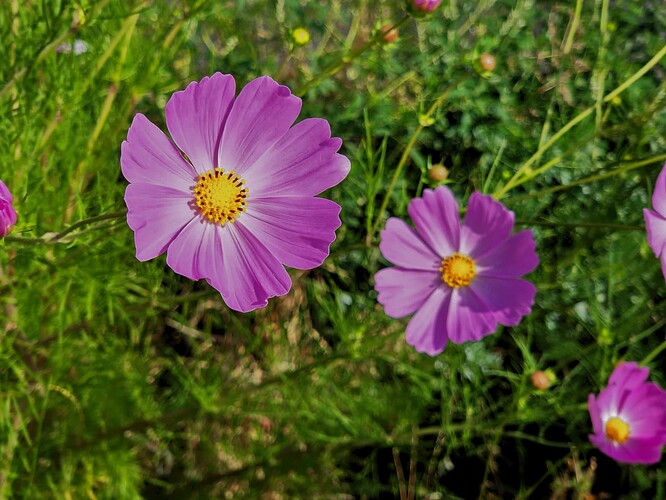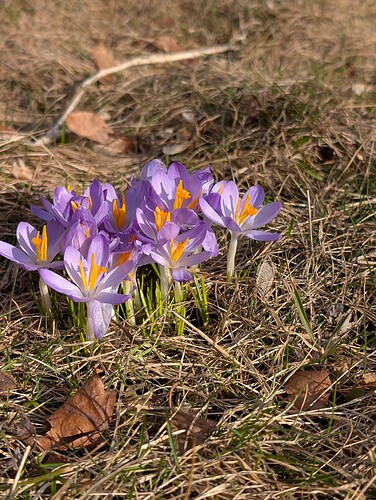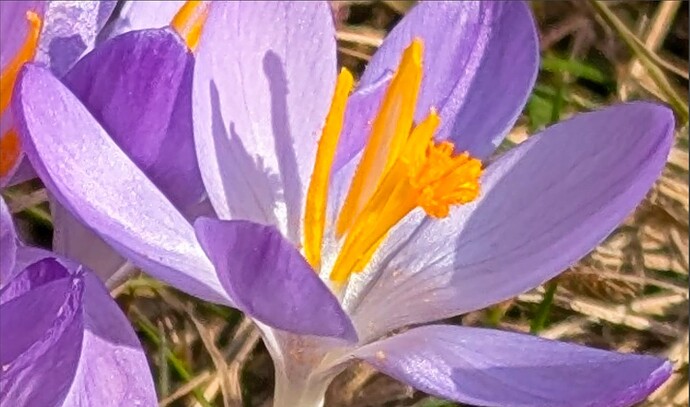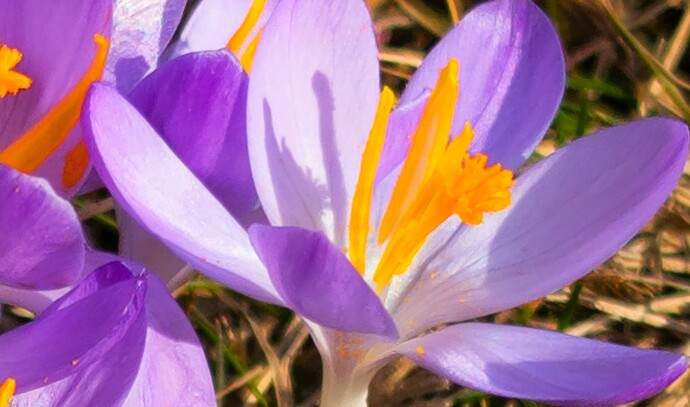The dynamic range of DNG avoids blown highlights and keeps colors saturated. The flower petals are saturated in real life, not washing out in the center of the flower.
Thanks Wlodek, for saying the quiet part out loud.
The rest of you people… Off you go, shoot in JPEG, edit in MS Paint, and be thankful for it! If this guy can live with a screenshot of a JPEG, so can we all.
There, case closed, RAW files are completely unnecesary.
You forgot to add ‘for low DR images which are already good’.
I’m amused. The photography world overflows with those who just want their RAW files to look like their OOC JPEGs. The OOC JPEG provided above looks processed, as it should, I don’t know if the highlights are blown out. They are desaturated, which is perceptually normal and what you might do intentionally for a natural looking final image. It looks reasonably realistic to me.
This is another example from a Pixel 9, captured in dual format, dng and jpg, in the DCI P3 color space. You will find below the out of camera jpg and a sample at 400%.
Below, a jpg created from the dng file converted to TIF using Adobe Bridge, then the TIF was edited in Photolab 8.
The dng file
PXL_20250403_211918672.RAW-02.ORIGINAL.dng (19.9 MB)
Lens profiles YES but camera profiles NO. They just gives you a little better starting point in your editing than without them.
Why not let the DXO customers decide whether they shall have to wait six months before DXO fix a profile, to use their new camera with Photolab as I had to do with my then new Sony A7 IV (one of Sonys best selling models) and many users of other brands have had to do to or if we ourselves decides to start from scratch without any camera-profiles at all. Everything is better than NOT being able to open the files at all.
The result efter the postprocessing will be the same anyway - it might just take same extra moves - why not let your users decide for themselves. You are deliberately obstructing your users from using a software you already have been payed for. … and yes, it is for sure possible to change model codes with a hexeditor and a batch update macro tool but that is not a good thing because it will harm our productivity. I know because that was what I used to do for six months
A further comparison of a Samsung ExpertRAW DNG image, vs. JPG straight out of camera . The DNG file was converted using Adobe Camera RAW.
Notice the lack of texture and some blown highlights in the JPG.
Top : DNG - converted to TIF;
Bottom : JPG
Very good example where we can see that even a phone “RAW/DNG”-image can be processed to a very good result too.
There are so many comments about how bad mobile images are (straight out of the phone) contra images taken with interchangeable lens cameras where the last always are postprocessed RAW and the phone images are not. It would have been interesting to add even a postprocessed RAW-file from a “dedicated camera” to this set too.
Thanks for that pass Pierre! Sometimes we need to set the records straight and conduct more serious comparisions than the ones we most of the times see.
I agree that it would indeed be interesting to see more comparisons - how sensors / different cameras compare against each other is a topic of endless debate, so maybe not super relevant to this thread, but interesting nonetheless.
There’s no arguing that millions of people shoot on mobile, and probably tens of thousands shoot RAW on mobile + other devices that also generate DNGs, and DxO PhotoLab should support those files no matter what, without the need of workarounds.
It is currently “impossible” [wink, wink] to make a proper comparison of a mobile DNG vs a compact or ILC camera with a bigger sensor and have a nice discussion with tons ef engagement, people shooting new examples, having debates, different processings in PhotoLab… nope, DxO says no to that. A shame, really, that they’re not only forcing us, but encouraging us to leave DxO PL for other software that does care about usability.
I recently bought ON1 (on sale for £50 at the time) and it is a great all-in-one editing tool. BUT it’s not at the same quality level as DxO (or Affinity or Topaz). Everything works but just not quite as good results as the equivalent tools elsewhere. I do use it for things like vacation shoots where I need to cull and edit a lot of shots quickly and am not looking for pro standard output. But for the 5-star shots I go back and re-edit with my usual combo of DxO/Affinity/Nik.
I also complained about this for years. Profile lenses on the largest sensor available, then apply the warp based on sensor size camera used. super easy… but the dxo folks insist on doing it the hardest slowest most expensive for them way possible. all because maybe its 1-2% “better” which no one but they will ever notice or even be able to measure. glad I mostly don’t care or use lens profiles anyway ![]()
I am not asking for the optical correction part, but the noise and color tools should be available. After all we paid to edit raw files, and all I am asking is to be able to open a file that is produced by MILLIONS of phones, compared with a few DSLRs.
But the majority of so called RAW files from phone cameras are not true RAW. They have already been processed in the phone. And DNG files are containers that might be any format on the inside.
A linear DNG file, where demosaicking has already been done, should be processable by a photo editor with ease. Unfortunately DxO’s position is as stated below :
Blockquote
In the case of Linear DNGs, the file is already “demosaiced”. We can’t access the raw information for processing, which unfortunately prevents us from applying our advanced algorithms and guaranteeing unparalleled image quality. Thus this type of DNG is not supported.
Link
In essence DxO’s argument for ignoring DNG files from phones is that they can’t apply their own advanced demosaicking if DNG is linear.
Let’s consider a JPG file : it is not raw but it can nevertheless be processed by Photolab. DxO does not apply its advanced demosaicking to JPG files.
Why should only non-linear DNG ( Bayer matrix raw mosaic ) files be processed by Photolab ? The benefit is that DNG files, linear or not, can have have more details and a wider color gamut than out-of-camera JPG files. Color balance and sharpening can be done in postprocessing rather than baked-in. Moreover, JPG compression artefacts are avoided when using DNG.
The quote you use to make conclusions about PhotoLab actually comes from an article about PureRAW only: https://support.dxo.com/hc/en-us/articles/4433898493329-Which-DNG-files-are-supported-by-DxO-PureRAW-as-input . Hence your subsequent reasoning lacks logic, imho. AFAIK, Linear DNG’s generated by PhotoLab (and probably PureRAW – same engine, just different sliders) are supported by PhotoLab, except for things like DeepPRIME and Lens Sharpness Optimization of course.
Related article, also on PureRAW only, and also obvious: https://support.dxo.com/hc/en-us/articles/17264186149021-When-are-you-going-to-support-Jpeg-and-Tiff-for-input
On smartphone support by PhotoLab, something perhaps for DxO to address: https://support.dxo.com/hc/en-us/articles/13560695483549-Support-for-RAW-generated-by-smartphones
Note that “RAW DNG” files (with data from CFA) still contain proprietary camera MakerNotes, that being another problem.
Partially off-topic:
Personally I prefer to use 16-bit RGB TIFFs as intermediate files because they have wider support, some compression schemes being still a problem, though. After all, DNG format was invented by Adobe to make people use Adobe products. Some DNG-specific tags are not fully documented, and the way to use them is a sweet secret of Lightroom or Photoshop internals, probably known only to selected third parties under NDA and possibly a suitable payment. Lastly, Adobe has too many lawyers to quarrel with. Think of their history of security breaches in AWS v1 cloud (which was well known to be unsafe at that time, so currently they use MS Azure, afaik), unclear Terms of Use which lead to legal actions by Adobe, or copyright issues.
Thank for the feedback. Indeed, the quote for Photolab is Here
Blockquote
DxO PhotoLab will accept DNG files created natively by supported cameras found in the list of supported cameras and lenses. DxO PhotoLab also supports DNG format if the original RAW format is supported, BUT only as long as they have been generated by Adobe Lightroom or Adobe DNG Converter (RAW DNG) without any further corrections (RAW-DNG) and without compression.
DxO PhotoLab also supports DNGs which were created with DxO PhotoLab and DxO PureRAW. However, automatic optical corrections and denoising will not be available for those DNGs as they have already been applied. So you’ll see the icon for “no optical module available”.
Just stumbled on this thread after not being able to open een DNG I took with the Samsung Expert RAW app on my Samsung S24.
Such a shame.
There’s a huge potential market out there with smartphone photographers who are currently not able to use DxO PhotoLab to edit their raw files and are forced to use Adobe Lightroom or apps on there phone for editing their DNG files.
Put this feature higher up in your backlog, please.
Phones are using computational photography to overcome limitations of their smaller sensors. Adobe released for iPhones the Indigo application which produce high quality DNG raw files.




